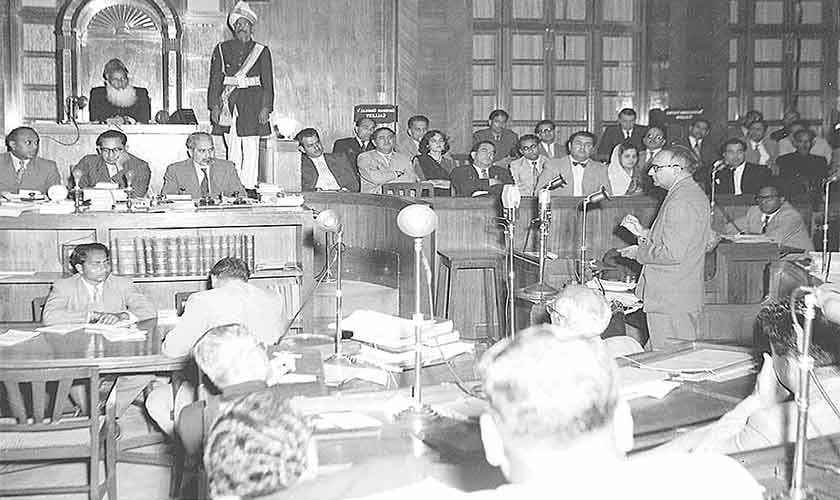The creation of Pakistan, as proposed by the Two-Nation Theory, asserts that Hindus and Muslims are separate nations incapable of coexisting. This claim invites several important inquiries:
1. What was the significant role of the Muslim-majority provinces in the establishment of Pakistan?
2. What motivated Jogendranath Mandal, a Dalit leader from Bengal, to advocate for the establishment of Pakistan?
3. Why did Abul Ala Maududi and other prominent Islamic religio-political parties oppose the Pakistan Movement?
4. What factors contributed to the separation of East Pakistan from West Pakistan within 24 years?
5. Why did it take nine years to establish Pakistan’s first constitution, even though the implementation of Islamic laws could have started earlier?
6. What were the reasons behind Quaid-i-Azam Muhammad Ali Jinnah’s appointment of Jogendranath Mandal as the inaugural chairman of the Constituent Assembly and later as the first minister for law and labour?
Let us explore these important questions.
### The Role of Muslim-Majority Provinces in Pakistan’s Establishment
The contribution of Muslim-majority provinces, especially Punjab, to the establishment of Pakistan has been extensively studied. Historians focusing on Pakistani nationalism note Punjab’s strategic significance during the Pakistan Movement, which played a crucial role in the All-India Muslim League’s (AIML) success in the 1945-46 general elections.
In the 1946 elections, the AIML won 73 of the 175 seats in Punjab, all of which were Muslim seats. These seats were primarily secured by notable landlords, who are believed to have allied with the AIML out of concern over potential land reforms suggested by the Indian National Congress. This alliance appears more as a landlord-protection strategy than a purely religious nationalism project.
Meanwhile, Khyber Pakhtunkhwa (formerly the North-West Frontier Province), the only Muslim-majority province in India without a Muslim League cabinet, strongly resisted the formation of Pakistan.
### Jogendranath Mandal and the Dalit Support for Pakistan
Bengali Hindus, particularly the Dalits under the leadership of Jogendranath Mandal, joined the Pakistan Movement with the expectation of a new political framework that would address systematic inequalities. The caste system severely limited individual freedom, whereas Islamic equality offered an alternative vision.
Their participation highlights a class struggle context, where marginalized groups sought emancipation through structural and social change rather than solely on the basis of religion or nationalism. This involvement indicates that social status challenges were a core driver behind the demand for a new state, more so than religious identification. Religion was instrumental in gaining support in some areas, but the movement’s central narrative involved resistance to colonial and feudal oppression as well.
### Opposition from Jamaat-i-Islami and Abul Ala Maududi
The Jamaat-i-Islami, led by Abul Ala Maududi, opposed the partition of India. They viewed the partition as detrimental to the concept of the *ummah*—the global Muslim community. Maududi argued that dividing the subcontinent with physical borders would weaken the spiritual and cultural ties among Muslims.
For Jamaat-i-Islami, partition was not just a political change but a fracture in the unity of Muslim identity. This challenged the ideal of the *ummah*, which called for unity beyond geographical divisions.
### Factors Leading to the Separation of East and West Pakistan
The separation of East Pakistan from West Pakistan in 1971, leading to the creation of Bangladesh, is attributed to a multitude of factors. Long-term causes include:
– The mistreatment of the Bengali language,
– Disputes over provincial autonomy.
Short-term causes involved the results of the 1970 general elections, while immediate events like the Searchlight Operation and foreign intervention by India and the USSR also played significant roles.
The complexity behind the 1971 partition raises questions about the more simplistic, mono-causal explanations often applied to the 1947 partition. A comparative analysis of both partitions using a unified theoretical framework could provide a deeper understanding of these significant historical events.
### Delayed Constitution-Making and Debates on Pakistan’s Identity
Pakistan’s foundation rooted in the Two-Nation Theory naturally spurred expectations regarding the immediate implementation of Islamic laws. However, the constitution took nine years to be established due to intense debates over the country’s identity and governance structure, including:
1. Whether the state should be theocratic or secular,
2. Preference for parliamentary or presidential democracy,
3. Choice between a federal or unitary system,
4. Division of power between a strong federation and autonomous provinces,
5. Whether the legislature should be bicameral or unicameral.
These complex discussions delayed the constitution-making process and questioned the very nature of the Pakistani state.
### Jogendranath Mandal’s Appointment by Quaid-i-Azam Muhammad Ali Jinnah
The appointment of Jogendranath Mandal, a Hindu Dalit leader, as the first chairman of the Constituent Assembly and later minister for law and labour by Quaid-i-Azam Muhammad Ali Jinnah is significant, especially in light of the Two-Nation Theory.
This choice reflected a nuanced understanding of nationhood, suggesting that Pakistan’s founders sought to include different social groups in the new state’s governance despite religious divides. Mandal’s involvement challenges the simplistic binary interpretation of the Two-Nation Theory and acknowledges the complex social dynamics within the independence struggle.
### Conclusion
The creation of Pakistan in 1947—like the formation of Bangladesh in 1971—was influenced by a complex web of interconnected factors rather than a single, overriding cause. To fully understand these historical events, it is essential to examine both partitions within a consistent analytical framework.
Moreover, the foundation of Pakistan can also be interpreted through the lens of class struggle, particularly in Bengal, where marginalized and oppressed communities aspired for improved social and economic conditions under an Islamic socialist vision. This perspective complements the religious nationalism narrative, highlighting the multifaceted nature of Pakistan’s creation.
https://www.thenews.com.pk/tns/detail/1346769-historys-unanswered-questions
